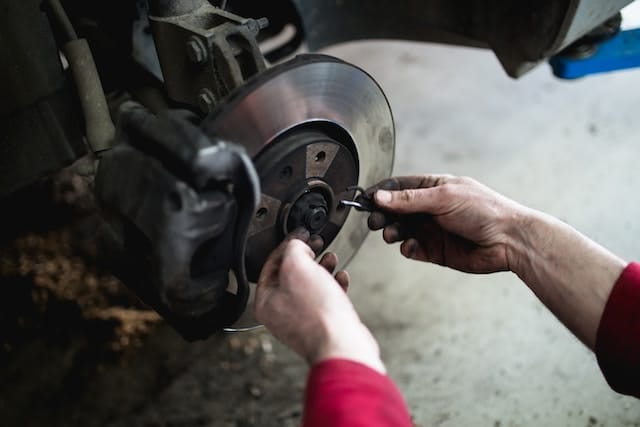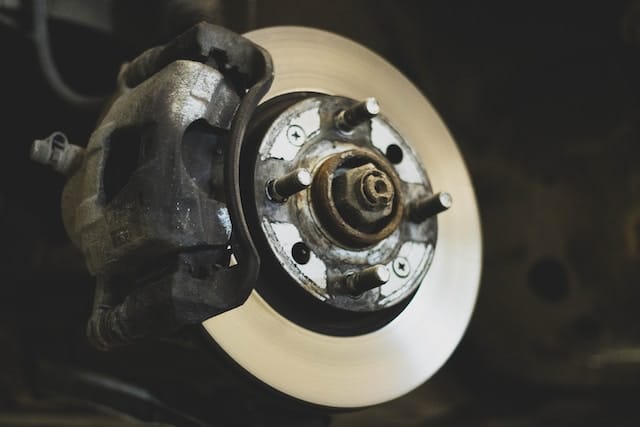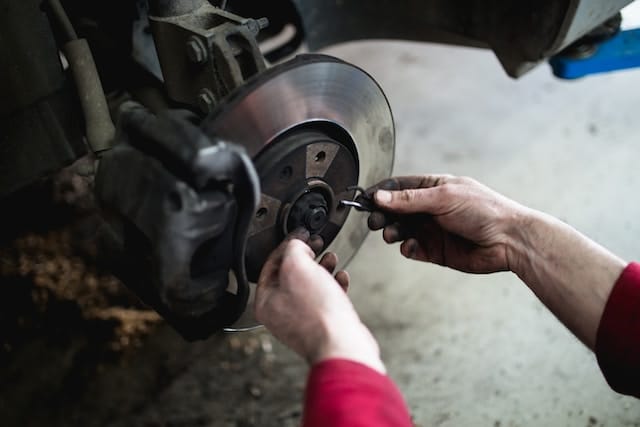
Feeling your car shaking when you hit the brakes isn’t just alarming; it’s a clear indicator that something isn’t quite right. There could be numerous causes for this unsettling experience, including worn or unbalanced tires, damaged brake system components, warped or uneven rotors, or worn brake shoes. Each of these conditions deteriorates the efficiency of your braking system, making your vehicle shake or vibrate when attempting to slow down.
In the ensuing sections of this article, we will delve into these primary causes and their associated symptoms. We will also discuss how regular maintenance, professional inspections, and, if necessary, component replacement, can resolve these issues, restore the efficiency of your braking system, and, ultimately, deliver a smoother and safer driving experience.
Common Causes of Car Shaking During Braking

Worn or unbalanced tires
Worn or unbalanced tires can significantly affect your car’s braking performance, leading to shaking while applying the brakes. Symptoms of tire-related issues may include uneven wear, vibrations at high speeds, or steering wheel wobble. To address these issues, consider tire rotation, balancing, and, if necessary, replacement. Regular tire maintenance can help prevent these issues and prolong the life of your tires.
Damaged brake system components
Various components make up the braking system, and damage to any of them can cause your car to shake when braking. Examples of critical parts include brake pads, calipers, and brake lines. If any of these components are damaged or worn, you may experience shaking or vibrations during braking. Consult a professional mechanic to inspect and replace any damaged parts to restore your braking system’s efficiency.
Warped or uneven rotors
Rotors play a crucial role in the braking process by providing a surface for brake pads to clamp onto and generate the friction needed to stop the car. Warped or uneven rotors can cause vibrations and shaking when braking. This issue can result from excessive heat, wear, or manufacturing defects. To address the problem, have your brake system checked by a professional who can resurface or replace the rotors as needed.
Worn brake shoes
Brake shoes are responsible for creating friction with the drum surface in drum brake systems, helping to slow down or stop the vehicle. Worn brake shoes can cause shaking, squealing, or a pulsating brake pedal during braking. If your brake shoes are worn beyond the manufacturer’s specifications, have them inspected and replaced by a professional mechanic to restore your braking performance.
Diagnosing Car Shaking Issues

When to seek professional assistance
When you apply the brakes, the car shakes noticeably? If you’re experiencing car shaking during braking and cannot pinpoint the cause, it’s essential to consult a professional mechanic. They have the expertise and equipment to diagnose and address the issue effectively.
The diagnostic process
Your mechanic will typically follow a series of steps to diagnose the problem, including:
- Test driving the vehicle to experience the shaking firsthand
- Visually inspecting the braking system for any signs of wear or damage
- Checking suspension components, lug nuts, and wheel bearings for any issues
Brakes Car Shakes: How the Braking System Works
The braking system of a vehicle is a crucial safety feature that allows the driver to control the vehicle’s speed and come to a complete stop when needed. Here’s an overview of how it works:
- When the driver presses the brake pedal, it activates a piston within the master cylinder.
- The master cylinder pressurizes the hydraulic fluid, also known as brake fluid.
- The pressurized fluid travels through brake lines and hoses, which are connected to the brake assemblies at each wheel.
- The fluid’s pressure is transmitted equally to the wheel cylinders or calipers positioned near each brake assembly.
- In vehicles with disc brakes, the pressurized fluid causes the brake calipers to squeeze the brake pads against the brake rotors. This creates friction and slows down or stops the vehicle.
- In vehicles with drum brakes, the pressurized fluid pushes the brake shoes outward against the inner surface of the brake drum, creating friction and decelerating the vehicle.
- As the vehicle slows down or stops, the kinetic energy is converted into heat, which is dissipated by the brake rotors or drums.
Preventative Measures and Maintenance
Taking care of your car and performing regular maintenance can help prevent issues with the braking system. Some preventative measures include:
Regular tire rotations and balancing to ensure even wear and proper weight distribution
Regular tire rotations and balancing involve periodically changing the position of tires on your vehicle and adjusting their weight distribution. This process helps promote even wear on tire treads and maintains optimal vehicle handling, providing a smoother, safer ride.
Periodic brake system inspections to catch issues early and avoid costly repairs
Periodic brake system inspections involve having a professional mechanic examine your vehicle’s brake components for signs of wear, damage, or malfunction. Catching issues early can help prevent more severe problems, ensuring your brakes remain reliable and avoiding costly repairs.
Using high-quality components that meet or exceed the manufacturer’s specifications
Using high-quality components that meet or exceed the manufacturer’s specifications means choosing brake parts designed to withstand the demands of your specific vehicle. These components are more likely to perform optimally and last longer, reducing the risk of brake failure and ensuring your car’s safety.
Following the manufacturer’s guidelines for maintenance schedules and part replacements
Following the manufacturer’s guidelines for maintenance schedules and part replacements means adhering to the recommended intervals for servicing your vehicle and replacing parts when necessary. This practice ensures that your car remains in peak condition, promoting longevity and reducing the likelihood of unexpected issues.
Why Your Car Shakes When You Apply the Brakes: FAQ

Why my car shakes when I apply the brakes?
Car shaking during braking can be caused by various factors, such as worn or unbalanced tires, damaged brake system components, warped or uneven rotors, or worn brake shoes.
How can I prevent my car from shaking when braking?
Regular tire maintenance, periodic brake system inspections, using high-quality components, and following the manufacturer’s maintenance guidelines can help prevent car shaking during braking.
When should I consult a professional mechanic for car shaking issues?
If you cannot pinpoint the cause of your car shaking during braking or the issue persists despite your efforts, it’s essential to consult a professional mechanic for a thorough inspection and diagnosis.
How can I maintain my braking system for optimal performance?
Perform regular maintenance, such as tire rotations and balancing, periodic brake system inspections, using high-quality components, and adhering to the manufacturer’s maintenance schedules and part replacement guidelines.
Can worn or unbalanced tires cause car shaking when braking?
Yes, worn or unbalanced tires can lead to vibrations and shaking during braking, affecting your car’s performance and safety. Regular tire maintenance, including rotation and balancing, can help address this issue.
Can squealing noises during braking indicate a problem with my brake system?
Yes, squealing noises during braking can be a sign of worn brake pads, glazed rotors, or other brake system issues. It’s essential to have your brakes inspected by a professional mechanic to determine the cause and address it promptly.
What causes grinding noises when applying the brakes?
Grinding noises during braking often indicate that the brake pads have worn down to the metal, causing the pad’s metal backing to scrape against the rotor. This can cause severe damage to the rotors and compromise your vehicle’s braking performance. It’s crucial to have your brake pads replaced and rotors inspected as soon as possible.
Are all brake noises a cause for concern?
While some brake noises can indicate a problem that requires attention, not all noises are a cause for concern. For example, slight squeaking during light braking might be due to moisture or dust. However, persistent or loud noises should be inspected by a professional mechanic to ensure your vehicle’s safety.
What can cause a clicking noise when braking?
A clicking noise during braking can result from loose or damaged brake hardware, such as caliper bolts, clips, or shims. It’s essential to have your brake system inspected by a professional mechanic to identify the issue and make the necessary repairs or replacements.
Can a warped rotor cause noise during braking?
Yes, a warped rotor can create noise during braking, usually as a pulsating or scraping sound. The uneven surface of a warped rotor can cause the brake pads to make intermittent contact, resulting in noise and vibrations. A professional mechanic can inspect your rotors and recommend resurfacing or replacement as needed.
What are the signs of warped or uneven rotors?
Symptoms of warped or uneven rotors may include vibrations in the brake pedal, steering wheel shaking during braking, and reduced braking performance. A professional mechanic can inspect your rotors and recommend resurfacing or replacement as needed.
Brakes Car Shakes : How often should I have my brake system inspected?
It’s a good practice to have your brake system inspected at least once a year or during regular maintenance intervals recommended by your vehicle’s manufacturer. However, if you notice any issues with your brakes, such as shaking, squealing, or reduced stopping power, consult a professional mechanic immediately.
Are there any DIY steps to identify the cause of car shaking when braking?
While there are some DIY steps you can take, such as checking tire wear and inflation or visually inspecting brake components for damage, it is always best to consult a professional mechanic for a thorough diagnosis and recommended solutions.
Can ignoring car shaking during braking lead to more severe problems?
Yes, ignoring car shaking during braking can result in more severe issues, such as reduced braking efficiency, compromised safety, and increased wear on other components. Addressing the problem early on can prevent costly repairs and ensure your vehicle remains safe and reliable.
How do worn brake pads affect my car’s shaking when braking?
Worn brake pads can cause reduced friction, resulting in decreased braking efficiency and potential shaking or vibrations when braking. Replacing worn pads can help restore optimal braking performance and eliminate shaking.
Can suspension issues cause car shaking during braking?
Yes, suspension problems, such as worn or damaged struts, shocks, or bushings, can contribute to car shaking during braking. A professional mechanic can inspect your suspension system and recommend necessary repairs or replacements.
Does the type of brake pad material impact car shaking when braking?
The brake pad material can affect your vehicle’s braking performance and the likelihood of experiencing shaking. High-quality brake pads made from materials designed for your specific vehicle can reduce the chances of car shaking during braking.
How can I tell if my car’s shaking is due to tire issues or brake system problems?
While both tire issues and brake system problems can cause car shaking during braking, some symptoms are more likely to be associated with one or the other. For example, if the shaking only occurs at high speeds, it may be related to tire balance, whereas if the shaking intensifies when braking, it could be due to a brake system issue. Consult a professional mechanic for a definitive diagnosis.
How often should I replace my brake pads and rotors?
The frequency of brake pad and rotor replacement depends on your driving habits, the type of brake pads and rotors you have, and your vehicle’s manufacturer recommendations. As a general rule, brake pads should be replaced every 30,000 to 70,000 miles, and rotors should be replaced every 60,000 to 70,000 miles. Always consult your vehicle’s owner’s manual for specific guidelines.


